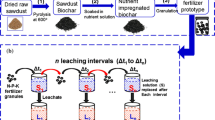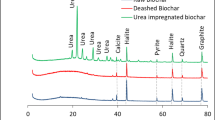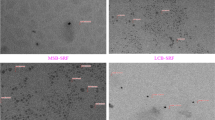Abstract
There has been an augmented attention for broad application of biochar-based slow-release fertilizer (SRF) to agricultural soils in recent years. It was synthesized four dissimilar biochar-based slow-release N-P-K fertilizer using nutrient impregnation technique and evaluated for nutrient release patterns, leaching behavior, yield, and soil health. Biochar prepared at 600 °C, impregnated into nutrient solution for 72 h, mixed with starch-PVA binder at 1:5 ratio to achieve an even coating followed by morpho-chemical characterization through scanning electron microscope which revealed that biochar pores appear to have locked with salt crystals of N-P-K nutrients. The highly porous microstructure of the four biochar allowed it to efficiently sorb NO3−, NH4+, PO43−, and K2O and form a nutrient-impregnated SRF. The nutrient release pattern study depicted that after 90 days of leaching the NO3− released 55.47–50.84%, NH4+ 55.47–50.84%, PO43− 65.31–68.52%, and K2O 74.33–77.27%. Thus, leaching capacity was highest in NO3− followed by K2O > PO43− > NH4+. Besides, among the four diverse biochar, the pine needle biochar (PNB) showed best nutrient retention/sorption capacity and lowest with maize stalk biochar (MSB). The SRF had lower nutrient release pattern than the fertilizer alone, demonstrating its slow-release behavior. After leaching with water equivalent to 462.18 mm rainfall (160 mL), approximately 47.60–58.27% NO3−, 47.84–65.40% NH4+, and 58.05–59.07% K2O was recovered in 40–50-cm column depth which indicated that SRF retained the nutrients in upper soil column and reduced its leaching potential. It also indicated that fertilizer was mobile as compared to the SRF. Biochar slowed the downward mobility of N and K in packed soil column. But, interestingly, phosphorus movement was enhanced by SRF in column and it increased its release potential in soil column. The crop yield (2.89–8.82%) and yield attribute characters were positively increased/enhanced by the biochar-based SRF than fertilization which was highest with BGB-SRF (black gram biochar-SRF) followed by MSB-SRF, LCB-SRF (Lantana camara biochar-SRF), and PNB-SRF. The nitrogen use efficiency followed as BGB-SRF (38.3%) > MSB-SRF (37.5%) > LCB-SRF (36.2%) > PNB-SRF (35.7%) than fertilizer (22.8%). The biochar-based SRF also improved the soil quality by increasing available nutrient (5.20–15.71%), oxidizable carbon (19.01–37.18%), and decreasing soil pH (11.74–3.73%). Soil quality improvement facilitated superior maize and black gram grain nutrient uptake (24.44–5.11%). Hence, the biochar-based SRF could be used as N-P-K-based slow-release fertilizer to maximize the functions of the N-P-K fertilizer when added to a sandy soil and minimize its environmental impact.



Similar content being viewed by others
References
Das SK (2014) Chemicals responsible for systemic acquired resistance in plant a critical review. J Atoms Mol 4(3):45–51
Das SK, Avasthe RK, Gopi R (2014) Vermiwash: use in organic agriculture for improved crop production. Popular kheti 2(4):45–46
Roy A, Das SK, Tripathi AK, Singh NU (2015) Biodiversity in North East India and their Conservation. Progress Agric 15(2):182–189
Barman H, Roy A, Das SK (2015) Evaluation of plant products and antagonistic microbes against grey blight (Pestalotiopsis theae), a devastating pathogen of tea. Afr J Microbiol Res 9(18):1263–1267
Das SK (2014) Scope and relevance of using pesticide mixtures in crop protection: a critical review. Int J Environ Sci Toxicol 2(5):119–123
Das SK, Mukherjee I, Kumar A (2015) Effect of soil type and organic manure on adsorption-desorption of flubendiamide. Environ Monit Assess 187(7):403
Das SK (2013) Mode of action of pesticides and the novel trends. A critical review. Int Res J Agric Sci Soil Sci 3(11):393–403
Das SK (2014) Recent development and future of botanical pesticides in India. Popular kheti 2(2):93–99
Mate CJ, Mukherjee I, Das SK (2014) Mobility of spiromesifen in packed soil columns under laboratory conditions. Environ Monit Assess 186(11):7195–7202
Das SK, Avasthe RK, Singh M, Sharma K (2015) Biobeds: on-farm biopurification for environmental protection. Curr Sci 109(9):1521–1521
Das SK, Avasthe RK (2015) Carbon farming and credit for mitigating greenhouse gases. Curr Sci 109(7):1223
Mukherjee I, Das SK, Kumar A (2012) A fast method for determination of flubendiamide in vegetables by liquid chromatography. Pestic Res J 24(2):159–162
Das SK, Mukherjee I (2011) Effect of light and pH on persistence of flubendiamide. Bull Environ Contam Toxicol 87:292–296
Das SK, Mukherjee I (2012) Effect of moisture and organic manure on persistence of flubendiamide in soil. Bull Environ Contam Toxicol 88:515–520
Das SK, Mukherjee I (2012) Dissipation of flubendiamide in/on Okra [Abelmoschus esculenta (L.) Moench] Fruits. Bull Environ Contam Toxicol 88:381–384
Das SK, Mukherjee I (2012) Flubendiamide transport through packed soil columns. Bull Environ Contam Toxicol 88:229–233
Das SK, Mukherjee I (2014) Influence of microbial community on degradation of flubendiamide in two Indian soils. Environ Monit Assess 186:3213–3219
Das SK (2014) Role of micronutrient in rice cultivation and management strategy in organic agriculture-a reappraisal. Agric Sci 5(09):765
Das SK (2014) Recent developments in clean up techniques of pesticide residue analysis for toxicology study: a critical review. Univers J Agric Res 2(6):198–202
Das SK, Mukherjee I (2017) Metsulfuron-methyl herbicide on dehydrogenase and acid phosphatase enzyme activity on three different soils. Int J Bio-resource Stress Manag 8(2):236–241
Das SK, Roy A, Barman H (2016) Fungi toxic efficiency of some plant volatile essential oils against plant pathogenic fungi. Afr J Microbiol Res 10(37):1581–1585
Mukherjee I, Das SK, Kumar A (2016) Degradation of flubendiamide as affected by elevated CO2, temperature, and carbon mineralization rate in soil. Environ Sci Pollut Res 23(19):19931–19939
Das SK, Mukherjee I, Roy A (2016) Alachlor and metribuzin herbicide on N2-fixing bacteria in a sandy loam soil. Int J Bio-resource Stress Manag 7(2):334–338
Barman H, Roy A, Das SK, Singh NU, Dangi DK, Tripathi AK (2016) Antifungal properties of some selected plant extracts against leaf blight (Alternaria alternata) in tomato. Res Crops 17(1):151–156
Mate CJ, Mukherjee I, Das SK (2015) Persistence of spiromesifen in soil: influence of moisture, light, pH and organic amendment. Environ Monit Assess 187(2):7
Mukherjee I, Das SK, Kumar A (2018) Atmospheric CO2 level and temperature affect degradation of pretilachlor and butachlor in Indian soil. Bull Environ Contam Toxicol 100(6):856–861
Das SK (2017) Rice cultivation under changing climate with mitigation practices: a mini review. Univers J Agric Res 5(6):333–337
Das SK (2015) Acid sulphate soil: management strategy for soil health and productivity. Popular kheti 3(2):2–7
Barman H, Das SK, Roy A (2018) Zinc in soil environment for plant health and management strategy. Univers J Agric Res 6:149–154
Das SK, Avasthe RK, Yadav A (2017) Secondary and micronutrients: deficiency symptoms and management in organic farming. Innovative farming 2(4):209–211
Das SK, Ghosh GK (2017) Soil hydro-physical environment as influenced by different biochar amendments. Int J Bio-resource Stress Manag 8(5):668–673
Das SK, Mukherjee I, Roy A (2017) Flubendiamide as new generation insecticide in plant toxicology: a policy paper. Adv Clin Toxicol 2:100–122
Das SK (2015) Integrated nematode management in chickpea Against Meloidogyne incognita-a view point. Univers J Agric Res 5(5):145–149
Das SK (2019) Soil carbon sequestration strategies under organic production system: a policy decision. Agrica 8(1):1–6
Das SK (2019) Qualitative evaluation of fodder trees and grasses in hill region. J Krishi Vigyan 7(2):276–279
Roy A, Das A, Das SK, Datta M, Datta J, Tripathi AK, Singh NU (2018) Impact analysis of National Agricultural Innovation Project (NAIP): a paradigm shift in income and consumption in Tripura. Green farming 9(3):559–564
Das SK, Avasthe RK, Singh M, Roy A (2018) Managing soil fertility under organic production system through integrated approach. Green farming 9(3):449–454
Das SK, Avasthe RK (2018) Plant nutrition management strategy: a policy for optimum yield. Acta Sci Agric 2(5):65–70
Singh NS, Mukherjee I, Das SK, Varghese E (2018) Leaching of clothianidin in two different Indian soils: effect of organic amendment. Bull Environ Contam Toxicol 100(4):553–559
Das SK, Avasthe RK, Singh M, Yadav A (2018) Soil health improvement using biochar application in Sikkim: a success story. Innovative farming 3(1):48–50
Barman H, Das SK, Roy A (2018) Future of nano science in technology for prosperity: a policy paper. Nanosci Technol 5(1):1–5
Das SK, Avasthe RK (2018) Development of innovative low cost biochar production technology. J Krishi Vigyan 7(1):223–225
Das SK, Avasthe RK, Sharma P, Sharma K (2017) Rainfall characteristics pattern and distribution analysis at Tadong East Sikkim. Indian journal of hill farming 30(2):326–330
Roy A, Singh NU, Tripathi AK, Yumnam A, Sinha PK, Kumar B, Das SK (2017) Dynamics of pulse production in north-east region of India- a state-wise analysis. Econ Aff 62(4):655–662
Das SK, Avasthe RK (2017) Livelihood improvement of rural tribal farmers through soil health management, input support system and training-a success story. Innovative farming 2(3):171–173
Das SK, Avasthe RK, Sharma K, Singh M, Sharma P (2017) Soil fertility assessment in different villages of East Sikkim District. Indian journal of hill farming 30(1):14–16
Das SK, Ghosh GK, Mukherjee I, Avasthe RK (2017) Nano-science for agrochemicals in plant protection. Popular Kheti 5(4):173–175
Das SK, Ghosh GK, Avasthe RK (2017) Biochar amendments on physico-chemical and biological properties of soils. Agrica 6(2):79–87
Sharma M, Rana M, Sharma P, Das SK (2016) Effect of different organic substrates and plant botanicals on growth and flowering of chincherinchee (Ornithogalum thyrosides Jacq). Indian journal of hill farming 29(2):72–74
Sharma P, Sharma K, Das SK (2016) Ethno medicinal plants uses in health care by the himalayan tribal people in India. Popular kheti 4(3):41–45
Gopi R, Kapoor C, Kalita H, Das SK, Avasthe RK (2015) A new report of downy mildew on buckwheat (Fagopyrum esculentum) caused by Perenospora sp in Sikkim. J Mycopathol Res 53(2):95–297
Roy A, Dkhar DS, Tripathi AK, Singh NU, Kumar D, Das SK, Debnath A (2014) Growth performance of agriculture and allied sectors in the north east India. Economic affairs 59(Special):783–795
Singh M, Das SK, Avasthe RK (2018) Effect of multipurpose trees on production and soil fertility on large cardamom based agro forestry system in Sikkim Himalaya. Indian J Agrofor 20(2):25–29
Mukherjee I, Das SK, Kumar A, Shukla L (2020) Sludge amendment affects the persistence, carbon mineralization and enzyme activity of atrazine and bifenthrin. Bull Environ Contam Toxicol 105(2):291–298
Das SK, Ghosh GK, Avasthe RK (2020) Ecotoxicological responses of weed biochar on seed germination and seedling growth in acidic soil. Environmental technology and innovation, 101074
Das SK, Ghosh GK, Avasthe RK (2020) Evaluating biomass-derived biochar on seed germination and early seedling growth of maize and black gram. Biomass conversion and biorefinery 1–14
Das SK, Ghosh GK, Avasthe RK (2020) Valorizing biomass to engineered biochar and its impact on soil, plant, water, and microbial dynamics: a review. Biomass conversion and biorefinery 1–17
Das SK (2020) Influence of phosphorus and organic matter on microbial transformation of arsenic. Environmental technology and innovation, 100930
Das SK, Avasthe RK (2020) Packages of organic nutrient management as soil policy for upgrading crop** system to restore soil productivity, organic agriculture, Shaon Kumar Das, IntechOpen, DOI: https://doi.org/10.5772/intechopen.91928. Available from: https://www.intechopen.com/books/organic-agriculture/packages-of-organic-nutrient-management-as-soil-policy-for-upgrading-crop**-system-to-restore-soil
Das SK, Ghosh GK (2020) Soil health management through low cost biochar technology. Biochar applications in agriculture and environment management, 193–206.
Gopi R, Avasthe RK, Kalita H, Yadav A, Das SK, Rai D (2020) Eco-friendly management of tomato late blight using botanicals, bio-control agents, compost tea and copper fungicides. Indian J Agric Sci 90(1):35–39
Das SK, Avasthe RK (2018) Soil organic nutrients management through integrated approach: a policy for environment & ecology. Environ Anal Ecol Stud 4(1):1–8
Das SK, Ghosh GK, Avasthe RK (2020) Applications of biomass derived biochar in modern science and technology. Environ Technol Innov 21:101306. https://doi.org/10.1016/j.eti.2020.101306
Das SK, Ghosh GK, Avasthe RK, Sinha K (2021) Compositional heterogeneity of different biochar: effect of pyrolysis temperature and feedstocks. J Environ Manage 278(2):111501. https://doi.org/10.1016/j.jenvman.2020.111501
Das SK, Ghosh GK, Avasthe RK, Sinha K (2020) Morpho-mineralogical exploration of crop, weed and tree derived biochar. J Hazard Mater 124370:124370. https://doi.org/10.1016/j.jhazmat.2020.124370
Das SK, Ghosh GK, Avasthe RK (2020) Biochar application for environmental management and toxic pollutant remediation. Biomass Conversion and Biorefinery. https://doi.org/10.1007/s13399-020-01078-1
Das SK, Ghosh GK, Avasthe RK (2020) Application of biochar in agriculture and environment, and its safety issues. Biomass Conversion and Biorefinery. https://doi.org/10.1007/s13399-020-01013-4
Das SK, Avasthe RK, Kalita H, Yadav A, Gopi R (2020) Organic soil nutrient practices in Sikkim and impact at field level for tribal farmers’: a success story. Biotica Research Today. 2, 2 (Feb. 2020), 24–26
Singh M, Gupta B, Das SK (2018) Soil organic carbon density under different agroforestry systems along an elevation gradient in north-western Himalaya. Range Management and Agroforestry. 39(1)” 8–13
Das SK, Avasthe RK, Singh M (2016) Carbon-negative biochar from weed biomass for agricultural research in India. Curr Sci 110(11):2045–2046
Das SK (2016) Screening of bioactive compounds for development of new pesticides: a mini review. Univers J Agric Res 4(1):15–20
Singh M, Gupta B, Das SK (2015) Assessment of economic viability of different agroforestry systems in Giri Catchment. Himachal Pradesh Economic Affairs 60(3):557–561
Barman H, Roy A, Das SK (2015) Evaluation of plant products and antagonistic microbes against leaf blight (Alternaria alternata), A devastating pathogen of Tomato. Trends Biosci 8(13):3374–3377
Acknowledgements
The author Shaon Kumar Das is thankful to the Director-ICAR Research Complex for NEH Region, Umiam, Meghalaya, India, and Department of Soil Science and Agricultural Chemistry, Palli Siksha Bhavana, Visva Bharati, Shantiniketan, India, for providing necessary fund and facility during the entire period of the research work.
Author information
Authors and Affiliations
Corresponding author
Ethics declarations
Competing interests
The authors declare no competing interests.
Additional information
Publisher's Note
Springer Nature remains neutral with regard to jurisdictional claims in published maps and institutional affiliations.
Rights and permissions
About this article
Cite this article
Das, S.K., Ghosh, G.K. Develo** biochar-based slow-release N-P-K fertilizer for controlled nutrient release and its impact on soil health and yield. Biomass Conv. Bioref. 13, 13051–13063 (2023). https://doi.org/10.1007/s13399-021-02069-6
Received:
Revised:
Accepted:
Published:
Issue Date:
DOI: https://doi.org/10.1007/s13399-021-02069-6




